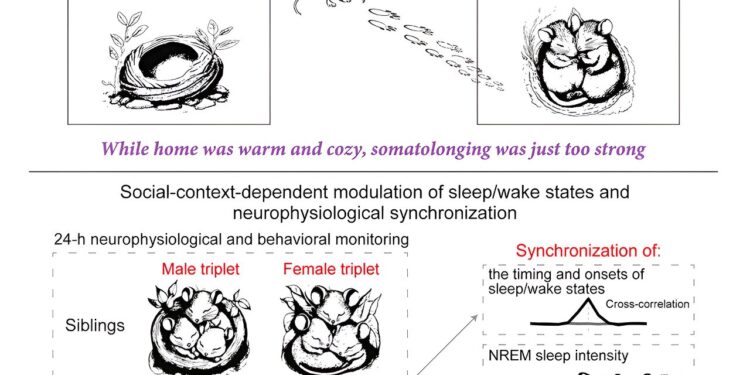Graphical summary. Credit: Current biology (2023). DOI: 10.1016/j.cub.2023.11.065
If you’re having trouble sleeping, contact with a bedmate may be the problem, say researchers at the University of Michigan.
Ada Eban-Rothschild, assistant professor in the UM Department of Psychology, and colleagues tracked mice’s sleep behavior in a social context. They noticed that these small rodents seek physical contact before falling asleep and huddle during sleep. They further show that cuddling during sleep is driven by an inner motivation for prolonged physical contact, which they called “somatolonging.”
The study, published in Current biologyhighlights the strong need for social contact in species other than humans.
“The absence of this type of contact was evident during the COVID-19 pandemic, during which people experienced somatolonging,” Eban-Rothschild said.
Cuddling while sleeping is not without cost; mice often disrupt everyone’s sleep. Likewise, in humans, co-sleeping is not always positive and insomnia can be transmitted between bed partners. So why do humans and other animals voluntarily choose situations that might compromise their sleep? Researchers don’t know yet.
On the other hand, people who co-sleep exhibit synchrony in several neurophysiological measures, including sleep onset/wake timing and REM sleep. In the study, researchers used advanced wireless devices and video recordings to monitor multiple mice within a group for 24 hours simultaneously.
The mice were willing to give up their preferred sleeping spot to access social contact. This suggests that motivation for prolonged physical contact drives grouping behavior, the researchers said.
They also noticed a coordination of several neurophysiological characteristics in co-sleeping individuals, including timing of falling asleep and waking up and sleep intensity.
Notably, the timing of rapid eye movements, or REM sleep, was synchronized in male siblings sleeping together, but not in female siblings sleeping together or in unfamiliar mice. This suggests that an individual’s internal state, such as feeling safe, controls the degree of synchronization.
More information:
Maria I. Sotelo et al, Neurophysiological and behavioral synchronization in group-living and sleeping mice, Current biology (2023). DOI: 10.1016/j.cub.2023.11.065
Provided by University of Michigan
Quote: Sleep may be compromised with a bed partner (December 27, 2023) retrieved December 27, 2023 from
This document is subject to copyright. Apart from fair use for private study or research purposes, no part may be reproduced without written permission. The content is provided for information only.



